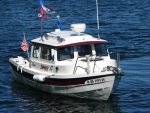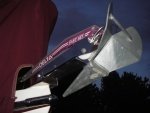C Sharp came to me with 150' of 1/4" chain rode, no rope. It has a Lewmar windlass, and the boat was previously used in the Chesapeake Bay where I assume it may have worked well there perhaps with a silty and muddy bottom?
However C Sharp is now in the PNW and I am wondering if that much change is overkill? I anchored for the first time a few days ago and despite a long scope the weight of the chain would pull from straight down. I'm not sure if this has any negative effects. The pros seem to be the chain runs really well through the windlass, there will be no chafing, but the cons would be a lot of weight in the bow, but then is that necessarily a bad thing on a 22?
However C Sharp is now in the PNW and I am wondering if that much change is overkill? I anchored for the first time a few days ago and despite a long scope the weight of the chain would pull from straight down. I'm not sure if this has any negative effects. The pros seem to be the chain runs really well through the windlass, there will be no chafing, but the cons would be a lot of weight in the bow, but then is that necessarily a bad thing on a 22?


